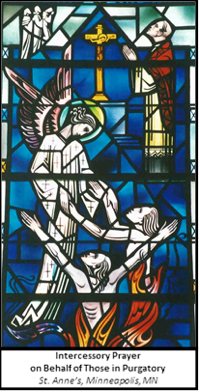November 2 is All Souls’ Day, the day in the liturgical year that we set aside to pray for the dead. November is the month when we especially remember those who have died.
 But why pray for the dead? There is no need to pray for those who have died and gone straight to heaven. This feast presumes that some who have died are imperfectly purified of their sinfulness, and while assured of the eventual benefits of eternal life, are barred from immediate access to heaven. Instead, they are held in an unknown place where they are cleansed of their sinfulness, and after an indeterminate time, are finally released to take their place at God’s throne.
But why pray for the dead? There is no need to pray for those who have died and gone straight to heaven. This feast presumes that some who have died are imperfectly purified of their sinfulness, and while assured of the eventual benefits of eternal life, are barred from immediate access to heaven. Instead, they are held in an unknown place where they are cleansed of their sinfulness, and after an indeterminate time, are finally released to take their place at God’s throne.
For centuries Catholics have said that Purgatory is the intermediate place of temporary punishment and purification, and that the length of time spent there is based upon the number and seriousness of one’s sins. The Church defined this doctrine at the Second Council of Lyons (1274), the Council of Florence (1439), and the Council of Trent (1545-1563). The term “Purgatory” still exists in Church literature today (Catechism of the Catholic Church, Nos. 1030-1032) despite the fact that it is not mentioned in the Bible. Two New Testament verses allude to a cleansing fire (1 Cor 3:15 and 1 Pt 1:7), and they have served as the basis for the concept of Purgatory which evolved from the Fifth to Thirteenth Centuries. Despite its long tradition, many contemporary scholars believe that neither verse is substantive enough to firmly establish Purgatory as a biblical reality, while others argue that there is nothing in Scripture to contradict it. Today the Church is more inclined to speak about “The Final Purification” (Documents of Vatican II, The Dogmatic Constitution of the Church, Lumen Gentium, No. 51).
A key biblical reason to pray for the dead is found in the Old Testament second book of Maccabees (2 Mac 12:38-46). This story recounts how Judas Maccabeus, a great Jewish general of the Second Century before Christ, had successfully led his army into a battle. A day after hostilities ceased, the troops who survived returned to the battlefield to gather up the bodies of their deceased comrades to give them a respectful burial. To their horror they found amulets, charm necklaces sacred to the idols of Jamnia, local pagan gods, tied around their necks and hidden under their armor. This was a grave sin against the First Commandment’s law against idols (Ex 20:2-6; Dt 5:7-9). Immediately “they turned to supplication and prayed that the sinful deed might be blotted out” (2 Mc 12:42). In fact, the stunned survivors who placed an extraordinarily high premium on faithful observance of the Mosaic Law were so aghast at this sin that they feared their fellow soldiers would be consigned to everlasting punishment. As firm believers in the resurrection, they were confident their prayers could help atone for the sins of the dead, release them from the punishment they deserved, and speed them on their journey to eternal light and peace. Consequently the survivors took up a collection and sent it to Jerusalem so an expiatory sacrifice could be offered in the Temple.
Consistent with this ancient Jewish practice, the Catholic Church has taught for centuries that our prayers aid those who have died, and the best prayer to offer for their intention is the Eucharist, the holy sacrifice of the Mass, the source and summit of our Christian life. The Church also recommends almsgiving, indulgences, and other works of penance for the deceased (Catechism, No. 1032).
November is the month of the year to especially pray for the dead, either for a family member or relative, someone else that you know, the deceased members of the parish, or those who have no one to pray for them. The Mass is the best option available, but any prayer or good deed offered for the spiritual welfare of the deceased is highly beneficial.




